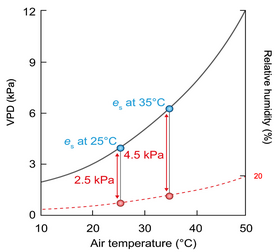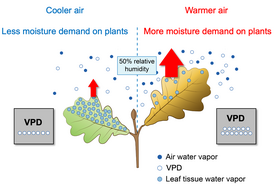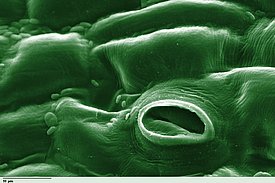
What is VPD? ¶
VPD, or Vapor Pressure Deficit, is a measure of the difference between the amount of moisture in the air and the amount it could hold when fully saturated (100% humidity).
Cooler air can hold less moisture, so it doesn't require plants to release much water. Warmer air, however, can hold more moisture, which means it puts more demand for moisture on plants (figure 1).

For example, figure 2 shows what happens to VPD during extreme heat waves. If the relative humidity stays at 20% (red dotted line) and the temperature goes up by 40%, i.e. 10°C, the VPD increases by 80%, i.e. 2.0 kPa (red arrows).
As the temperature rises due to global warming, the air can hold more moisture. However, the amount of moisture in the air has not increased as quickly, partly because ocean evaporation has decreased over the past two decades for reasons we don't fully understand yet. This has led globally to an increase in VPD.
What does high VPD mean for plants? ¶
High VPD makes plants close their stomata (small openings on their leaves) to reduce water loss and prevent damage to their water transport systems. However, this also reduces the amount of carbon dioxide (CO2) they take in for photosynthesis, which affects their growth. At the same time, transpiration (water movement through the plant and evaporation from the leaves) increases with high VPD to a point where it either remains high or starts to decrease, which can further increase plant water stress.
Elevated VPD has been suggested as having a significant role in recent and future drought-associated mortality events in all forested continents. For example, recent die-offs (widespread and fast mortality events) of conifers in southwestern USA have been more strongly correlated with VPD than with either temperature or precipitation anomalies. In addition to its direct impact on plant physiology, high VPD accelerates evaporation from soils, thus creating a vicious cycle of soil drying, warming of land surfaces, and plant water stress. All these mechanisms combined make VPD a major determinant of global water resources and vegetation water stress.
This video shows how Prof. Charlotte Grossiord and her team work toward disentangling the effects of vapor pressure deficit from those of other factors such as heat and drought (WSL, 2020).

